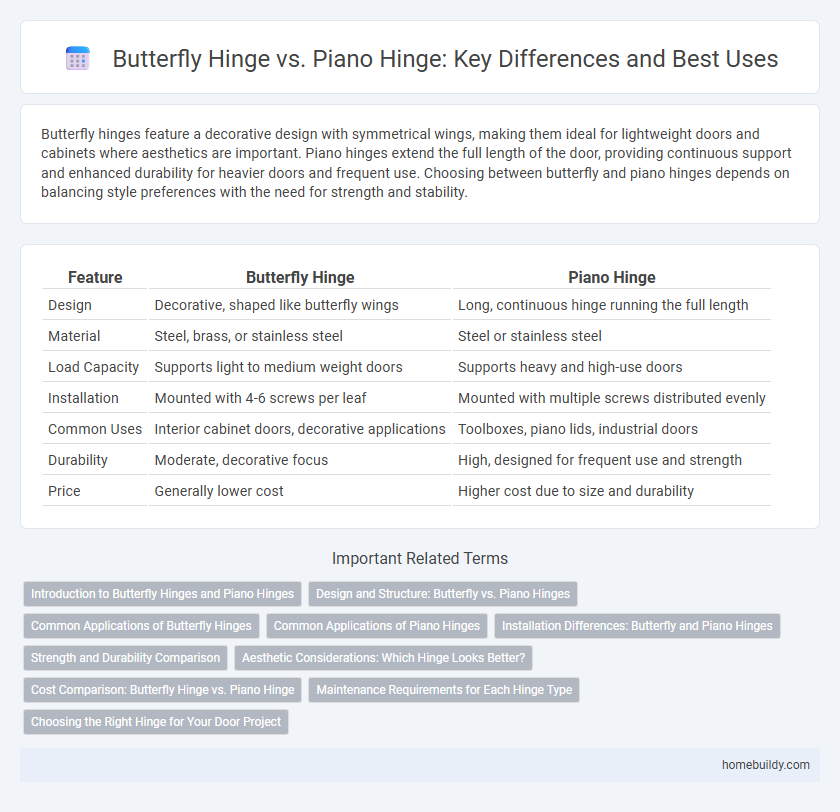Butterfly hinges feature a decorative design with symmetrical wings, making them ideal for lightweight doors and cabinets where aesthetics are important. Piano hinges extend the full length of the door, providing continuous support and enhanced durability for heavier doors and frequent use. Choosing between butterfly and piano hinges depends on balancing style preferences with the need for strength and stability.
Table of Comparison
| Feature | Butterfly Hinge | Piano Hinge |
|---|---|---|
| Design | Decorative, shaped like butterfly wings | Long, continuous hinge running the full length |
| Material | Steel, brass, or stainless steel | Steel or stainless steel |
| Load Capacity | Supports light to medium weight doors | Supports heavy and high-use doors |
| Installation | Mounted with 4-6 screws per leaf | Mounted with multiple screws distributed evenly |
| Common Uses | Interior cabinet doors, decorative applications | Toolboxes, piano lids, industrial doors |
| Durability | Moderate, decorative focus | High, designed for frequent use and strength |
| Price | Generally lower cost | Higher cost due to size and durability |
Introduction to Butterfly Hinges and Piano Hinges
Butterfly hinges feature a decorative design with two symmetrical wings that resemble a butterfly, commonly used on cabinets and lightweight doors for aesthetic appeal and moderate support. Piano hinges, also known as continuous hinges, extend the full length of the door or lid, providing uniform strength and durability ideal for heavy doors and piano lids. Both hinges serve distinct purposes: butterfly hinges enhance visual design while piano hinges ensure consistent alignment and robust functionality.
Design and Structure: Butterfly vs. Piano Hinges
Butterfly hinges feature decorative, symmetrical designs with two wings resembling butterfly wings, optimized for light to medium-duty applications on cabinet doors and furniture, emphasizing aesthetics alongside function. Piano hinges consist of a continuous metal strip running the entire length of the door or panel, providing uniform weight distribution and robust structural support ideal for heavy-duty, long-lasting applications like piano lids or toolboxes. The segmented design of butterfly hinges allows for easy installation in smaller spaces, whereas piano hinges excel in strength and alignment due to their uninterrupted construction.
Common Applications of Butterfly Hinges
Butterfly hinges are commonly used in lightweight, decorative applications such as jewelry boxes, cabinet doors, and small chests due to their ornate design and ease of installation. Their wings provide a wide surface area for secure attachment on thin wood or metal surfaces, making them ideal for fine woodworking projects. Unlike piano hinges, butterfly hinges do not span the entire length of the door, allowing for aesthetic versatility in smaller openings.
Common Applications of Piano Hinges
Piano hinges are commonly used in applications requiring continuous support and smooth operation along the entire length of the door or panel, such as piano lids, toolboxes, and storage chests. Their design distributes weight evenly, making them ideal for heavy or long doors where durability and stability are critical. This contrasts with butterfly hinges, which are often chosen for decorative purposes on smaller cabinets or lightweight doors.
Installation Differences: Butterfly and Piano Hinges
Butterfly hinges require precise alignment of two symmetrical plates connected by a central pin, making installation straightforward for lightweight doors and cabinets. Piano hinges extend the full length of the door, distributing weight evenly and necessitating more screws along the length, which demands careful measurement for consistent screw spacing. Both types must be mortised into the door and frame to achieve a flush fit, but piano hinges often require more extensive routing due to their continuous design.
Strength and Durability Comparison
Butterfly hinges offer moderate strength and decorative appeal, making them suitable for lightweight doors or cabinets, but they typically lack the robustness required for heavy or frequently used doors. Piano hinges, also known as continuous hinges, provide superior durability and strength by distributing weight evenly along the entire door length, enhancing resistance to stress and wear over time. For applications demanding long-term reliability and heavy-duty support, piano hinges outperform butterfly hinges in structural integrity and lifespan.
Aesthetic Considerations: Which Hinge Looks Better?
Butterfly hinges feature intricate, decorative patterns that enhance the visual appeal of vintage or ornate furniture, making them ideal for projects requiring aesthetic charm. Piano hinges, with their long, continuous design, offer a sleek and minimalist look that suits modern and streamlined applications. Choosing between the two depends on the desired style, where butterfly hinges emphasize artistic detail and piano hinges prioritize subtle elegance.
Cost Comparison: Butterfly Hinge vs. Piano Hinge
Butterfly hinges are generally more affordable than piano hinges due to their smaller size and simpler design, making them ideal for lightweight doors and decorative applications. Piano hinges, also known as continuous hinges, tend to be more expensive because they run the full length of the door, providing enhanced stability and durability for heavier or high-traffic doors. The choice between these hinges often depends on budget constraints and the specific functional requirements of the door installation.
Maintenance Requirements for Each Hinge Type
Butterfly hinges require regular lubrication and tightening to prevent squeaking and misalignment due to their exposed pivot points. Piano hinges, being continuous along the entire door edge, distribute stress evenly, reducing the frequency of adjustments and typically requiring less maintenance overall. Both hinge types benefit from periodic inspection, but piano hinges generally offer greater durability and stability with minimal upkeep.
Choosing the Right Hinge for Your Door Project
Butterfly hinges provide decorative appeal and are ideal for lightweight cabinet doors, offering ease of installation and smooth operation. Piano hinges run the entire length of a door, delivering robust support and enhanced durability for heavier or high-use doors. Selecting the right hinge depends on door weight, material, and functional requirements, ensuring optimal performance and longevity in your door project.
butterfly hinge vs piano hinge Infographic

 homebuildy.com
homebuildy.com